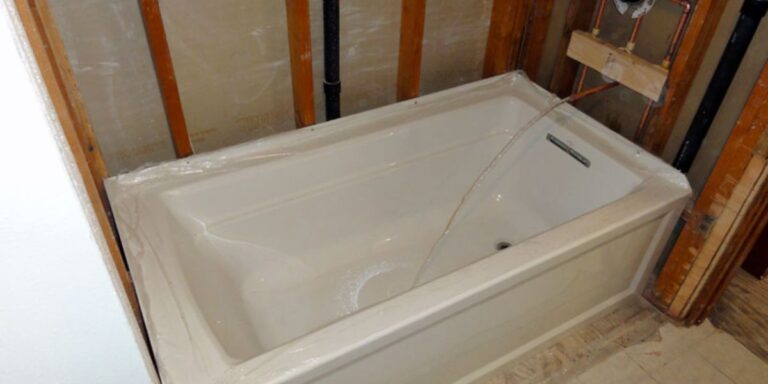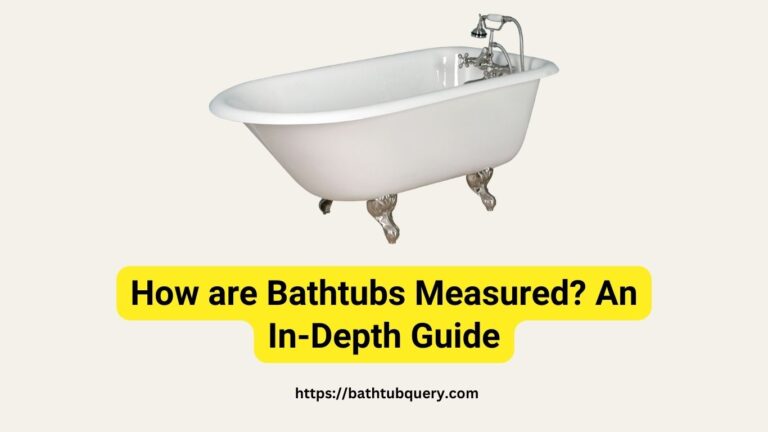Do Acrylic Tubs Feel Cheap? Factors Discussed
As I was researching bathtubs for my recent bathroom remodel, I’ll admit the lightweight feeling of acrylic tubs gave me pause. Coming from a old cast iron tub that felt sturdy and substantial, I wondered if choosing an acrylic model would come across as flimsy or cheap.
This concern sent me down a rabbit hole of tub material comparisons and design considerations to find out if acrylic tubs can provide that same sense of high-end luxury that you get from soaking in a porcelain or stone bathtub.
After weighing the pros and cons, I realized that acrylic shouldn’t be automatically dismissed as a lower-end option. With careful product selection and design choices, acrylic tubs can look and feel just as high-quality as pricier materials.
Read this artice: Are Acrylic Bathtubs Toxic? Tub Certification and Testing
Acrylic’s Lightweight Feel
When I first started testing out acrylic tubs at showrooms and big box stores, the lightness threw me for a loop. Having been conditioned to expect a bathtub to have some heft, the feather-light acrylic models seemed almost hollow in comparison.
Though acrylic sheets can be produced in thicker gauges for more rigidity, the standard thicknesses used in tub manufacturing result in a product that can be lifted and carried by a single person.
You know that cheap, flimsy feeling when you knock on a thin hollow-core interior door? That initial impression gave me pause about acrylic tubs feeling sturdy enough for the long haul. I worried that in a few years, it might start flexing and creaking like those interior doors that get loose on their hinges over time.
However, as I did more research I learned that acrylic tub walls can be reinforced and stabilized in ways that prevent flexing or buckling, even with thin shell construction. Manufacturers use structural ribbing or composite reinforcing layers to add stability and rigidity. This results in acrylic tubs that feel more substantial and emulate the solidity of heavier cast iron or stone materials.
Affordability Factor
It didn’t take long for me to realize one of the biggest contributors to the perception of acrylic tubs feeling cheap is their price point. Acrylic is one of the most budget-friendly bathtub materials. It is exponentially less expensive than natural stone or fired porcelain options, which can run tens of thousands for high-end custom models.
The raw manufacturing costs of acrylic are substantially lower, and those material savings get passed along in the retail pricing. So in comparison, acrylic often ends up being the “entry level” tub option for consumers looking to save money on a bath upgrade. This undoubtedly affects perceptions around acrylic feeling like a lower-end material, even when it is crafted into well-made products.
I found I had to shift my mindset when it came to cost. Rather than focusing on getting the most expensive tub my budget would allow, I reframed my thinking to prioritize quality construction and features over price alone. This opened up more possibilities for getting a higher-end acrylic tub that would stand the test of time.
Longevity of Quality Acrylic Tubs
The longevity and durability of acrylic was another concern I had when weighing tub options. No one wants to have to replace a tub in just a few years due to material failure or deterioration. I was pleasantly surprised to learn just how long a well-made acrylic tub can last.
With proper care and maintenance, high quality acrylic bathtubs can have a lifespan of 15 years or longer. Some sources estimate 20 years is not unreasonable for acrylic tubs in residential settings. This is comparable to the average service life of ceramic or enameled steel tubs.
Avoiding any major cracks, punctures, or gouges that allow water ingress is key. These types of structural damage can undermine the tub’s integrity long before the acrylic material itself deteriorates. Careful use along with prompt repair of minor chips or scratches will keep an acrylic tub going strong for over a decade.
Advancements in acrylic formulas also mean better scratch resistance compared to earlier generations of products. Hard minerals in water can still pose abrasion problems over time, but improved surface hardness helps acrylic withstand years of use with a glossy, like-new sheen.
Style and Design Elements
Probably the biggest factor in making an acrylic tub look and feel high-end is overall style, form, and design details. The material itself allows for an incredible range of shapes, colors, and finishes. Streamlined contemporary designs tend to have the most refined, luxurious look and feel.
Attention to design elements like integrated tile flanges or deck-mount faucetry also elevates the overall quality of the bathing experience. It creates a seamless, custom-feel that avoids the utilitarian look of drop-in tubs with exposed rims and basic wall-mount faucets.
Small design touches go a long way. Muttering features like textured tub floors provide added sensory appeal. Built-in lumbar support, armrests, and ergonomic shapes provide comfort and an added sense of luxury during a leisurely soak.
How Other Materials Compare
While researching tubs it was useful for me to directly compare acrylic models with other tub types like porcelain, stone, and enameled steel. Here’s a quick run-down of what I discovered about how those other materials feel:
- Porcelain – Porcelain enameled steel tubs have a glassy smooth surface and dense solid feel similar to ceramic sinks. Porcelain can chip over time but provides substantial weight.
- Natural Stone – Stone tubs like marble and granite feel cool and extremely solid. They provide that high-end spa bathroom vibe but require intensive sealing. Natural stone is also very heavy, often requiring reinforcement to handle weight.
- Resin Composite – Composite tubs infused with crushed stones or other aggregates emulate the look of stone with a lighter more flexible feel. Most designs are focused on mimicking stone visuals.
- Enameled Steel – Enameled cast iron or steel tubs have that classic vintage feel. The glossy enamel coating over heavy cast iron provides industrial-grade durability but also retains heat well.
Price-wise, porcelain tubs start around $500 and go up from there. Stone tubs range from $1,500 on the very low end to over $10,000 for premium marble or granite. Composite and enameled steel offer a middle ground around $1,000 to $3,000.
So acrylic holds its own as an attractive, cost-effective option. With some designer details and material innovations, acrylic tubs can provide a similar high-end bathing experience on par with pricier tub types. focus on quality of construction and design can elevate acrylic above its cheap reputation.
At the end of the day, choosing the right tub is about matching your overall bathroom style, needs, and of course budget. But don’t count acrylic out as an inferior option before taking a closer look. With an open mind, you may find the perfect acrylic tub that checks all the boxes in terms of look, feel, and performance.
Takeaway Tips
Here are my top recommendations if you’re on the fence about acrylic tubs feeling too lightweight or cheap:
- Seek out reinforced acrylic construction for added rigidity
- Test out floor models to assess fit, finish, and material thickness
- Focus on quality and features like textured floors, lumbar support, etc.
- Choose contemporary streamlined designs for refined high-end looks
- Consider deck-mount faucets, built-in tiles, and other designer details
- Compare warranties between brands to ensure longevity and coverage
- Maintain finish by prompt repair of scratches and avoid abrasive cleaners
With the right combination of material quality, structural reinforcement, and attention to detail, you can absolutely get an acrylic tub that provides that same luxurious bathing experience as pricier options. Don’t let preconceived notions about acrylic dissuade you from finding the perfect tub to match your space and style!
- 9 Best Cleaners For Acrylic Tubs – They Provide Deep Clean
- What Cleaners Are Safe for Acrylic Tubs?
- What Not To Use On Acrylic Tubs? 5 Things To Avoid
- Acrylic vs Porcelain Bathtubs: Which One Is Best For You?

William J. Bullock is a licensed plumber with over 15 years of experience installing and repairing bathtubs. He runs his own plumbing company in Greenville and serves residential and commercial clients. William is dedicated to providing honest, transparent advice to help homeowners make informed decisions about their bathroom renovations.
He has established expertise in selecting bathtubs, planning custom installations, diagnosing issues, and completing repairs. William aims to share practical tips and reliable recommendations based on extensive hands-on work. When he isn’t on a job site, William enjoys spending time with his family and volunteering at local community events. He takes pride in delivering quality service and enjoys helping people upgrade their homes.







